(chapter 5) A Concise and Practical Introduction to Programming Algorithms in Java
- 1. 1A Concise and Practical Introduction to Programming Algorithms in Java © 2009 Frank Nielsen Frank NIELSEN [email protected] A Concise and Practical Introduction to Programming Algorithms in Java Chapter 5: Classes and objects
- 2. 2A Concise and Practical Introduction to Programming Algorithms in Java © 2009 Frank Nielsen So far...: Executive summary ● Lecture 1: Variable, Expression, Assignment ● Lecture 2: Loops (for while do) Conditional structures (if else switch) Boolean predicate and connectors (|| &&) Loop escape break ● Lecture 3: functions (static) and recursion (terminal or not) ● Lecture 4: Objects
- 3. 3A Concise and Practical Introduction to Programming Algorithms in Java © 2009 Frank Nielsen Indenting source code (.java) ● Increase code readibility ● Avoid mistyping bugs (matching { }) Source code formatter, pretty printer, beautifier Different conventions are possible (but choose one) Implemented more or less in Software (S/W) Nedit, Jcreator, Jindent, etc...
- 4. 4A Concise and Practical Introduction to Programming Algorithms in Java © 2009 Frank Nielsen http://java.sun.com/docs/codeconv/ Identing source code (.java) Examples for if else conditions
- 5. 5A Concise and Practical Introduction to Programming Algorithms in Java © 2009 Frank Nielsen Indenting source code (.java) http://java.sun.com/docs/codeconv/
- 6. 6A Concise and Practical Introduction to Programming Algorithms in Java © 2009 Frank Nielsen Indenting source code (.java) ● Bytecode size and indentation: Does not change fundamentally ● Bytecode is not human readable Demo Indent.java: notepad Jcreator & produced bytecode Indent.class open bytecode
- 7. 7A Concise and Practical Introduction to Programming Algorithms in Java © 2009 Frank Nielsen Identing source code (.java) Sometimes in Java code (Internet), comments include commands for generating automatically documentation by other tools: ... Like javadoc (paradigm literate programming, etc.) http://java.sun.com/j2se/javadoc/ La classe TC se trouve a: http://www.enseignement.polytechnique.fr/informatique/profs/Julien.Cervelle/TC/ Class TC
- 8. 8A Concise and Practical Introduction to Programming Algorithms in Java © 2009 Frank Nielsen Functions in Java ● Static functions that returns a type (eventually void) ● Functions are called inside the main procedure (or in other function body) ● Displaying and calling function are different (be not confused with SciLab or Maple System.out.println(function()); ● Java is a compiled OO language , not an interpreter
- 9. 9A Concise and Practical Introduction to Programming Algorithms in Java © 2009 Frank Nielsen Functions: void/display Java cannot cast void type into a String, so the compiler javac generates an error. (type checking) class Functions { static void PascalTriangle(int depth) {//... return ; } public static void main(String[] toto) { System.out.println(PascalTriangle(5)); } } 'void' type not allowed here'void' type not allowed here
- 10. 10A Concise and Practical Introduction to Programming Algorithms in Java © 2009 Frank Nielsen Functions: void/display Java is not an interpreter like SciLab or Maple Functions are called within a block of instructions... ... not in the console!!!!class Functions { static double f(double x) {return x;} static void main(String[] args) { } }
- 11. 11A Concise and Practical Introduction to Programming Algorithms in Java © 2009 Frank Nielsen Variables: static or not... Static variables are declared in the class bodyclass body class Toto { static int count1, count2; ... } Otherwise non-static variables (usual) are declared in function bodiesfunction bodies (main, etc.) public static void main(String[] args) {double x;int i;} ● Variables are kept in memory in their function scope {...} ● Static variables are kept in memory and can be shared by several functions...
- 12. 12A Concise and Practical Introduction to Programming Algorithms in Java © 2009 Frank Nielsen class Functions { static int count1, count2; static void f1(){count1++;} static void f2(){count2++;} public static void main(String[] args) { count1=0; count2=0; for(int i=0;i<1000;i++) { double rand=Math.random(); if (rand<0.5) {f1();} else {f2();} } System.out.println("count1:"+count1); System.out.println("count2:"+count2); } } static or not...
- 13. 13A Concise and Practical Introduction to Programming Algorithms in Java © 2009 Frank Nielsen Java is pass by value ...and arrays and objects are pass by reference class BadSwap { static void swap(int arg1, int arg2) { int tmp; tmp=arg1; arg1=arg2; arg2=tmp; } public static void main(String[] toto) { int a=3; int b=2; System.out.println("a:"+a+" b:"+b); swap(a,b); System.out.println("After the swap..."); System.out.println("a:"+a+" b:"+b); } }
- 14. 14A Concise and Practical Introduction to Programming Algorithms in Java © 2009 Frank Nielsen Managing memory & functions When calling a function f, the current function (main) indicates .....where to write the value of the result To obtain the result, function f uses a local memory In that local memory, values of arguments are available //current function body {} int a=3,b=2; swap(a,b) Memory address main Value of a Value of b s w a p Value of arg1 Value of arg2 Value of tmp
- 15. 15A Concise and Practical Introduction to Programming Algorithms in Java © 2009 Frank Nielsen static void swap(int arg1, int arg2) { int tmp; tmp=arg1; arg1=arg2; arg2=tmp; } public static void main(String[] toto) { int a=3; int b=2; swap(a,b); } Memory address main 3 2 1. Create memory for local variables of function main 2. Assign values for a and b b a
- 16. 16A Concise and Practical Introduction to Programming Algorithms in Java © 2009 Frank Nielsen static void swap(int arg1, int arg2) { int tmp; tmp=arg1; arg1=arg2; arg2=tmp; } public static void main(String[] toto) { int a=3; int b=2; swap(a,b); } 3. create local space for function swap Memory address main 3 2 s w a p arg1 arg2 tmp b a
- 17. 17A Concise and Practical Introduction to Programming Algorithms in Java © 2009 Frank Nielsen static void swap(int arg1, int arg2) { int tmp; // 0 is default value tmp=arg1; arg1=arg2; arg2=tmp; } public static void main(String[] toto) { int a=3; int b=2; swap(a,b); } 4. evaluate expression for getting values of arg1 and arg2 swap(a,b) becomes swap(3,2) Memory address main 3 2 s w a p arg1 arg2 tmp b a 3 2 0
- 18. 18A Concise and Practical Introduction to Programming Algorithms in Java © 2009 Frank Nielsen static void swap(int arg1, int arg2) { int tmp; // 0 is default value tmp=arg1; arg1=arg2; arg2=tmp; } public static void main(String[] toto) { int a=3; int b=2; swap(a,b); } 5. Execute instruction tmp=arg1 Memory address main 3 2 s w a p arg1 arg2 tmp b a 3 2 3
- 19. 19A Concise and Practical Introduction to Programming Algorithms in Java © 2009 Frank Nielsen static void swap(int arg1, int arg2) { int tmp; // 0 is default value tmp=arg1; arg1=arg2; arg2=tmp; } public static void main(String[] toto) { int a=3; int b=2; swap(a,b); } Memory address main 3 2 s w a p arg1 arg2 tmp b a 2 2 3 6. Execute instruction arg1=arg2
- 20. 20A Concise and Practical Introduction to Programming Algorithms in Java © 2009 Frank Nielsen static void swap(int arg1, int arg2) { int tmp; // 0 is default value tmp=arg1; arg1=arg2; arg2=tmp; } public static void main(String[] toto) { int a=3; int b=2; swap(a,b); } Memory address main 3 2 s w a p arg1 arg2 tmp b a 2 3 3 7. Execute the sequence of instructions in the swap block Notice that here the swapped has been performed
- 21. 21A Concise and Practical Introduction to Programming Algorithms in Java © 2009 Frank Nielsen static void swap(int arg1, int arg2) { int tmp; // 0 is default value tmp=arg1; arg1=arg2; arg2=tmp; } public static void main(String[] toto) { int a=3; int b=2; swap(a,b); } Memory address main 3 2 s w a p arg1 arg2 tmp b a 2 3 3 5. Execute the sequence of instructions in the swap block
- 22. 22A Concise and Practical Introduction to Programming Algorithms in Java © 2009 Frank Nielsen static void swap(int arg1, int arg2) { int tmp; // 0 is default value tmp=arg1; arg1=arg2; arg2=tmp; // we omitted return ; } public static void main(String[] toto) { int a=3; int b=2; swap(a,b); } Memory address main 3 2 b a 8. Return result of function swap (here void!!!) 9. Release memory allocated for swap Variables a and b have kept their original values
- 23. 23A Concise and Practical Introduction to Programming Algorithms in Java © 2009 Frank Nielsen Memory for static variables class SwapStatic { static int a,b; static void swap() { ... } public static void main(String[] toto) { a=3; b=2; swap(); } } Memory address main 3 2 b a Memory for static variables of class SwapStatic swaptmp0
- 24. 24A Concise and Practical Introduction to Programming Algorithms in Java © 2009 Frank Nielsen class SwapStatic { static int a,b; static void swap() { int tmp;// ok not to be static tmp=a; a=b; b=tmp; } public static void main(String[] toto) { a=3; b=2; System.out.println("a:"+a+" b:"+b); swap(); System.out.println("After the swap..."); System.out.println("a:"+a+" b:"+b); } } By passing using static
- 25. 25A Concise and Practical Introduction to Programming Algorithms in Java © 2009 Frank Nielsen Memory for arrays and pass by reference Arrays are allocated a continuous memory location for storing TYPE elements The value of the array variable is a reference to the beginning of the array Memory for arrays (heap) TypeElement [ ] tab= new TypeElement[size] tab[0] tab[1] tab[size-1] Array variable tab is a reference
- 26. 26A Concise and Practical Introduction to Programming Algorithms in Java © 2009 Frank Nielsen Memory management using new Type [] tab=new Type[Expression]; ● Evaluate Expression to get an integer value. ● Arrays are stored not in the local function memory, but rather in the global program memory: heap, tas en francais ● A cell (array element) in the heap (program memory) is accessible by any function which has as a local (non-static) variable a reference to the array.
- 27. 27A Concise and Practical Introduction to Programming Algorithms in Java © 2009 Frank Nielsen class ArrayReference { public static void swap(int [] t, int i, int j) { int tmp; tmp=t[i]; t[i]=t[j]; t[j]=tmp; } public static void Display(int [] tab){... » public static void main(String[] args) { //int [] array=new int[10]; int [] array={0,1,2,3,4,5,6,7,8,9}; Display(array); swap(array,1,2); Display(array); } } 0 1 2 3 4 5 6 7 8 9 0 2 1 3 4 5 6 7 8 9
- 28. 28A Concise and Practical Introduction to Programming Algorithms in Java © 2009 Frank Nielsen Memory management using new 4 4 4 4 4 4 4 4 4 4 4 4 0 4 4 4 4 4 4 4 class BuildArray{ // Return a reference to an array public static int [] BuildArray(int size, int defaultval) { int [] result=new int[size]; for(int i=0;i<size;i++) result[i]=defaultval; return result; } public static void Zero(int[] tab, int pos) { tab[pos]=0; } public static void main(String [] argarray) { int v []=BuildArray(10,4); Display(v); Zero(v,2); Display(v); }
- 29. 29A Concise and Practical Introduction to Programming Algorithms in Java © 2009 Frank Nielsen Synopsis of this lecture ● Objects and records (fields, enregistrements) ● Object constructors ● Class type variables: References ● Functions on objects: Methods ● Array of objects ● Examples
- 30. 30A Concise and Practical Introduction to Programming Algorithms in Java © 2009 Frank Nielsen Why do we need objects? Java is an oriented-object (OO) programming language Encapsulate functions/data acting on a same domain For example, the String type Allows one to work on complex entities: Data structures For examples: ● Dates are triplets of numbers (MM/DD/YYYY) ● 2D point with co-ordinates (x,y) ● Student: Lastname, Firstname, Group, etc. These are called object records (fields)
- 31. 31A Concise and Practical Introduction to Programming Algorithms in Java © 2009 Frank Nielsen Declaring classes and objects ● Choose record/field names (enregistrement) ● Define a type of each record ● Similar to variables but without keyword static ● Class is then a new type with name... ... the class name
- 32. 32A Concise and Practical Introduction to Programming Algorithms in Java © 2009 Frank Nielsen Toy example public class Date { int dd; int mm; int yyyy; } Fields (champs/enregistrements) are also called object variables Do not have the leading keyword static Let day be a variable of type Date then day.dd day.mm dd.yyyy are variables of type int
- 33. 33A Concise and Practical Introduction to Programming Algorithms in Java © 2009 Frank Nielsen Toy example public class Student { String Lastname; String Firstname; int Company; double [ ] Marks; ... } Class Student encapsulates data attached to a student identity.
- 34. 34A Concise and Practical Introduction to Programming Algorithms in Java © 2009 Frank Nielsen Constructors To use an object, we first need to build it We construct an object using the instruction new But first, we need to define a constructor for the class A constructor is a method (non-static function) ... ...bearing the class' name This method does not return a result but assigns... ...values to the object's field Use this.field to access field of the object
- 35. 35A Concise and Practical Introduction to Programming Algorithms in Java © 2009 Frank Nielsen public class Date { int dd; int mm; int yyyy; // Constructor public Date(int day, int month, int year) {this.dd=day; this.mm=month; this.yyyy=year;} } Constructors Date day=new Date(23,12,1971); Create an object of type Date
- 36. 36A Concise and Practical Introduction to Programming Algorithms in Java © 2009 Frank Nielsen public class Date { int dd; int mm; int yyyy; public Date(int day, int month, int year) { this.dd=day; this.mm=month; this.yyyy=year; } } Public class YYY stored in YYY.java class TestDate{ public static void main(String args) { Date day=new Date(23,12,1971); } } Filename: Date.java Filename: TestDate.java
- 37. 37A Concise and Practical Introduction to Programming Algorithms in Java © 2009 Frank Nielsen Constructors ● Possibly several constructors (with different signatures) ● Best, to define a single one with all fields initialized ● Keyword this means the currently built object (not compulsory to write it explicitly but recommended) public Date(int day, int month, int year) {dd=day; this.mm=month; yyyy=year; } ● If no constructor is built, the system uses the by-default one (not recommended) Date day=new Date();// see poly pp. 59-61 day.yyyy=1971;
- 38. 38A Concise and Practical Introduction to Programming Algorithms in Java © 2009 Frank Nielsen The null object ● This object is common to all classes ● Not possible to assign its fields ● Nor retrieve values of its fields, either (exception nullPointerException raised) ● Used for initializing a variable of type object: Student stud=null; ● It is often recommender to check if an object is null or not: if( stud!=null) stud.company=2;
- 39. 39A Concise and Practical Introduction to Programming Algorithms in Java © 2009 Frank Nielsen Functions/methods on objects Objects can be parameters of functions static TypeF F(Object1 obj1, ..., ObjectN objN) Functions may return an object as a result: static boolean isBefore (Date d1, Date d2) static Date readDate()
- 40. 40A Concise and Practical Introduction to Programming Algorithms in Java © 2009 Frank Nielsen Examplepublic class Date { int dd; int mm; int yyyy; public static final String[ ] months={ "January", "February", "March", "April", "May", "June", "July", "August", "September", "October", "November", "December" }; // Constructor public Date(int day, int month, int year) { this.dd=day; this.mm=month; this.yyyy=year; } }
- 41. 41A Concise and Practical Introduction to Programming Algorithms in Java © 2009 Frank Nielsen Example class TestDate{ static void Display(Date d){ System.out.println("The "+d.dd+" "+Date.months[d.mm- 1]+" of "+d.yyyy); } static boolean isBefore(Date d1, Date d2) { boolean result=true; if (d1.yyyy>d2.yyyy) result=false; if (d1.yyyy==d2.yyyy && d1.mm>d2.mm) result=false; if (d1.yyyy==d2.yyyy && d1.mm==d2.mm && d1.dd>d2.dd) result=false; return result; } public static void main(String[] args) { Date day1=new Date(23,12,1971); Display(day1); Date day2=new Date(23,6,1980); System.out.println(isBefore(day1,day2)); } }
- 42. 42A Concise and Practical Introduction to Programming Algorithms in Java © 2009 Frank Nielsen class TestDate{ ... static Date lireDate() { int jj, mm, aaaa; System.out.println("Jour?"); jj=TC.lireInt(); System.out.println("Mois?"); mm=TC.lireInt(); System.out.println("Annee?"); aaaa=TC.lireInt(); Date day=new Date(jj,mm,aaaa); return day; } public static void main(String[] args) { Display(lireDate()); } }
- 43. 43A Concise and Practical Introduction to Programming Algorithms in Java © 2009 Frank Nielsen Variable of Type Object: Reference A variable of type Object is a reference on that object It stores the memory address of this referenced object Thus when we write: Date day1=new Date(23,12,1971); Date day2=day1; Display(day2); day2.mm=6; Display(day1); The date d1 is not copied, only the reference of... ...d1 is assigned to d2
- 44. 44A Concise and Practical Introduction to Programming Algorithms in Java © 2009 Frank Nielsen Copying objects... To copy (clone) an object to another we need to do it fieldwise // Two Scenarii: // day2 has already been created... day2.dd=day1.dd; day2.mm=day1.mm; day2.yyyy=day1.yyyy; // day2 object has not yet been created... static Date Copy(date day1) { Date newdate=new Date (day1.dd,day1.mm,day1.yyyy); return newdate; } ... Date d2=Copy(d1);
- 45. 45A Concise and Practical Introduction to Programming Algorithms in Java © 2009 Frank Nielsen Comparing two objects... Do not use == for object equality To compare objects, use a tailored predicate: static boolean isEqual(Date d1, Date d2) { return (d1.dd == d2.dd && d1.mm == d2.mm & d1.yyyy== d2.yyyy); }
- 46. 46A Concise and Practical Introduction to Programming Algorithms in Java © 2009 Frank Nielsen Comparing two objects... public static void main(String[] args) { Date day1=new Date(23,12,1971); Date day2=day1; // beware not copying here. Just memory reference Date day3=new Date(23,12,1971); System.out.println(isEqual(day1,day3)); System.out.println(day1); System.out.println(day2); System.out.println(day3); } Physical (memory) versus logical equality
- 47. 47A Concise and Practical Introduction to Programming Algorithms in Java © 2009 Frank Nielsen Array of objects ● Since classes defines new types... ... we can create array of objects ● To build an array of objects: new nameT[sizearray] Date [ ] tabDates=new Date[31]; ● When an array of object is built, the elements Date[i] are all initialized to the null object.
- 48. 48A Concise and Practical Introduction to Programming Algorithms in Java © 2009 Frank Nielsen Example public class Date { ... void Display() { System.out.println(dd+" "+months[mm-1]+" "+yyyy); } ... } public class XEvent { Date when; String what; public XEvent(Date d, String text) { this.when=d; this.what=text; } } Filename XEvent.java Filename Date.java
- 49. 49A Concise and Practical Introduction to Programming Algorithms in Java © 2009 Frank Nielsen public class TestXEvent { public static void Display(XEvent e) { System.out.print(e.what+": "); e.when.Display(); } public static void main(String [] args) { Date d1=new Date(26,6,2008); XEvent e1=new XEvent(d1,"Birthday Julien"); Display(e1); XEvent [] tabEvent=new XEvent[5]; tabEvent[0]=e1; } }
- 50. 50A Concise and Practical Introduction to Programming Algorithms in Java © 2009 Frank Nielsen public class TestXEvent {public static void Display(XEvent e) { System.out.print(e.what+": "); e.when.Display(); } public static boolean older(XEvent e1, XEvent e2) {return Date.isBefore(e1.when,e2.when);} public static XEvent oldest(XEvent[] tab) { XEvent result=tab[0]; for(int i=1;i<tab.length;++i) if (older(tab[i],result)) result=tab[i]; return result; } public static void main(String [] args) { Date d1=new Date(26,6,2003); XEvent e1=new XEvent(d1,"Birthday Julien"); Date d2=new Date(20,11,2000); XEvent e2=new XEvent(d2,"Birthday Audrey"); Date d3=new Date(23,6,1971); XEvent e3=new XEvent(d3,"Birthday Me"); Display(e1); XEvent [] tabEvent=new XEvent[3]; tabEvent[0]=e1;tabEvent[1]=e2;tabEvent[2]=e3; System.out.print("Oldest person::");Display(oldest(tabEvent)); } }
- 51. 51A Concise and Practical Introduction to Programming Algorithms in Java © 2009 Frank Nielsen Objects with array members Fields of objects may be arrays themselves always built with new Type[sizearray] // sizearray might be an expression, i.e., 3*n+2 It is not necessary at compile time to know statically... .... the array sizes class Polynome{ int degree; double [ ] coefficients; };
- 52. 52A Concise and Practical Introduction to Programming Algorithms in Java © 2009 Frank Nielsen Strings: Basic objects in Java ● A string of character is an object with type String ● A variable of type String is a reference on that object: String school= ''Ecole Polytechnique''; String vars=school; ● Once built, a string object cannot be modified ● Beware: use only for moderate length strings, otherwise use the class StringBuffer
- 53. 53A Concise and Practical Introduction to Programming Algorithms in Java © 2009 Frank Nielsen Class String: Some methods A method is a function or procedure on an object class Method Length() : gives the number of characters String s= ''anticonstitutionnellement''; System.out.println(s.length()); Method equals(): s1.equals(s2): Predicate that returns true if and only if the two strings s1 and s2 are made of the same sequence of characters. String s1=''Poincare''; String s2=TC.lireMotSuivant(); System.out.println(s1.equals(s2)); Beware: s1==s2 is different! It compares the reference of the strings. (Physical versus logical equality test)
- 54. 54A Concise and Practical Introduction to Programming Algorithms in Java © 2009 Frank Nielsen Class String in action...
- 55. 55A Concise and Practical Introduction to Programming Algorithms in Java © 2009 Frank Nielsen Class String: More methods Method charAt(): s.charAt(i) gives the character at the (i+1)th position in string s. String s= ''3.14159265''; System.out.println(s.charAt(1));
- 56. 56A Concise and Practical Introduction to Programming Algorithms in Java © 2009 Frank Nielsen Method compareTo(): u.compareTo(v) compares lexicographically the strings u with v. String u=''lien'', v=''lit'', w=''litterie''; System.out.println(u.compareTo(v)); System.out.println(v.compareTo(w)); http://java.sun.com/j2se/1.4.2/docs/api/java/lang/String.html From Javadoc...
- 57. 57A Concise and Practical Introduction to Programming Algorithms in Java © 2009 Frank Nielsen Lexicographic total order on strings ● If there is a position k at which strings differ: this.charAt(k)-anotherString.charAt(k): String s1="Marin",s2="Martin"; // -11 from i to t int index=3;// meaning 4th pos System.out.println(s1.compareTo(s2)); System.out.println(s1.charAt(index)-s2.charAt(index)); ● else the difference of string lengths: this.length()-anotherString.length(): String s3="Bien",s4="Bienvenue"; System.out.println(s3.compareTo(s4)); System.out.println(s3.length()-s4.length());
- 58. 58A Concise and Practical Introduction to Programming Algorithms in Java © 2009 Frank Nielsen Class String: More methods
- 59. 59A Concise and Practical Introduction to Programming Algorithms in Java © 2009 Frank Nielsen Demystifying the main function class ClassName { public static void main(String[ ] args) { ... } } Function main has an array of string of characters as arguments These strings are stored in args[0], args[1], ... ... when calling java main s0 s1 s2 s3 Use Integer.parseInt() to convert a string into an integer
- 60. 60A Concise and Practical Introduction to Programming Algorithms in Java © 2009 Frank Nielsen Parsing arguments in the main function
- 61. 61A Concise and Practical Introduction to Programming Algorithms in Java © 2009 Frank Nielsen Parsing arguments in the main function
- 62. 62A Concise and Practical Introduction to Programming Algorithms in Java © 2009 Frank Nielsen More evolved Java program skeleton... 2 versus (!=) 3 (2,1) (3,4) class Point { int x,y; Point(int xx, int yy){x=xx;y=yy;} public void Display() {System.out.println("("+x+","+y+")")} } // end of class Point class Skeleton { // Static class variables static int nbpoint=0; static double x; static boolean [] prime; static int f1(int p){return p/2;} static int f2(int p){return 2*p;} public static void main(String [] argArray) { System.out.println(f2(f1(3))+" versus (!=) "+f1(f2(3))); Point p,q; p=new Point(2,1); nbpoint++; q=new Point(3,4); nbpoint++; p.Display();q.Display(); } }
- 63. 63A Concise and Practical Introduction to Programming Algorithms in Java © 2009 Frank Nielsen


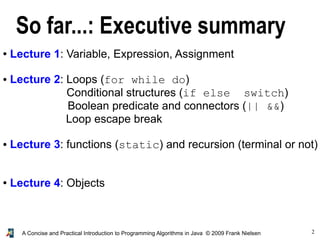

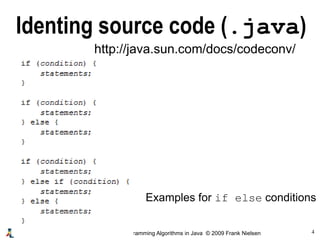




![9A Concise and Practical Introduction to Programming Algorithms in Java © 2009 Frank Nielsen
Functions: void/display
Java cannot cast void type into a String,
so the compiler javac generates an error.
(type checking)
class Functions
{
static void PascalTriangle(int depth)
{//...
return ;
}
public static void main(String[] toto)
{
System.out.println(PascalTriangle(5));
}
}
'void' type not allowed here'void' type not allowed here](https://image.slidesharecdn.com/programmingalgorithmsjava-5-140701005408-phpapp02/85/chapter-5-A-Concise-and-Practical-Introduction-to-Programming-Algorithms-in-Java-9-320.jpg)
![10A Concise and Practical Introduction to Programming Algorithms in Java © 2009 Frank Nielsen
Functions: void/display
Java is not an interpreter like SciLab or Maple
Functions are called within a block of instructions...
... not in the console!!!!class Functions
{
static double f(double x)
{return x;}
static void main(String[] args)
{ }
}](https://image.slidesharecdn.com/programmingalgorithmsjava-5-140701005408-phpapp02/85/chapter-5-A-Concise-and-Practical-Introduction-to-Programming-Algorithms-in-Java-10-320.jpg)
![11A Concise and Practical Introduction to Programming Algorithms in Java © 2009 Frank Nielsen
Variables: static or not...
Static variables are declared in the class bodyclass body
class Toto
{
static int count1, count2;
...
}
Otherwise non-static variables (usual) are
declared in function bodiesfunction bodies (main, etc.)
public static void main(String[] args)
{double x;int i;}
● Variables are kept in memory in their function scope {...}
● Static variables are kept in memory and can be shared by
several functions...](https://image.slidesharecdn.com/programmingalgorithmsjava-5-140701005408-phpapp02/85/chapter-5-A-Concise-and-Practical-Introduction-to-Programming-Algorithms-in-Java-11-320.jpg)
![12A Concise and Practical Introduction to Programming Algorithms in Java © 2009 Frank Nielsen
class Functions
{
static int count1, count2;
static void f1(){count1++;}
static void f2(){count2++;}
public static void main(String[] args)
{
count1=0;
count2=0;
for(int i=0;i<1000;i++)
{
double rand=Math.random();
if (rand<0.5)
{f1();}
else
{f2();}
}
System.out.println("count1:"+count1);
System.out.println("count2:"+count2);
}
}
static or not...](https://image.slidesharecdn.com/programmingalgorithmsjava-5-140701005408-phpapp02/85/chapter-5-A-Concise-and-Practical-Introduction-to-Programming-Algorithms-in-Java-12-320.jpg)
![13A Concise and Practical Introduction to Programming Algorithms in Java © 2009 Frank Nielsen
Java is pass by value
...and arrays and objects are pass by reference
class BadSwap
{
static void swap(int arg1, int arg2)
{
int tmp;
tmp=arg1;
arg1=arg2;
arg2=tmp;
}
public static void main(String[] toto)
{
int a=3;
int b=2;
System.out.println("a:"+a+" b:"+b);
swap(a,b);
System.out.println("After the swap...");
System.out.println("a:"+a+" b:"+b);
}
}](https://image.slidesharecdn.com/programmingalgorithmsjava-5-140701005408-phpapp02/85/chapter-5-A-Concise-and-Practical-Introduction-to-Programming-Algorithms-in-Java-13-320.jpg)
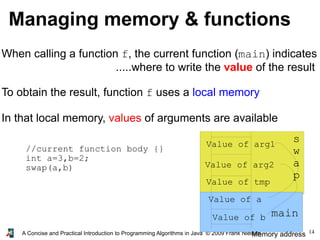
![15A Concise and Practical Introduction to Programming Algorithms in Java © 2009 Frank Nielsen
static void swap(int arg1, int arg2)
{
int tmp;
tmp=arg1;
arg1=arg2;
arg2=tmp;
}
public static void main(String[] toto)
{
int a=3;
int b=2;
swap(a,b);
}
Memory address
main
3
2
1. Create memory for local variables of function main
2. Assign values for a and b
b
a](https://image.slidesharecdn.com/programmingalgorithmsjava-5-140701005408-phpapp02/85/chapter-5-A-Concise-and-Practical-Introduction-to-Programming-Algorithms-in-Java-15-320.jpg)
![16A Concise and Practical Introduction to Programming Algorithms in Java © 2009 Frank Nielsen
static void swap(int arg1, int arg2)
{
int tmp;
tmp=arg1;
arg1=arg2;
arg2=tmp;
}
public static void main(String[] toto)
{
int a=3;
int b=2;
swap(a,b);
}
3. create local space for function swap
Memory address
main
3
2
s
w
a
p
arg1
arg2
tmp
b
a](https://image.slidesharecdn.com/programmingalgorithmsjava-5-140701005408-phpapp02/85/chapter-5-A-Concise-and-Practical-Introduction-to-Programming-Algorithms-in-Java-16-320.jpg)
![17A Concise and Practical Introduction to Programming Algorithms in Java © 2009 Frank Nielsen
static void swap(int arg1, int arg2)
{
int tmp; // 0 is default value
tmp=arg1;
arg1=arg2;
arg2=tmp;
}
public static void main(String[] toto)
{
int a=3;
int b=2;
swap(a,b);
}
4. evaluate expression for getting values of arg1 and arg2
swap(a,b) becomes swap(3,2)
Memory address
main
3
2
s
w
a
p
arg1
arg2
tmp
b
a
3
2
0](https://image.slidesharecdn.com/programmingalgorithmsjava-5-140701005408-phpapp02/85/chapter-5-A-Concise-and-Practical-Introduction-to-Programming-Algorithms-in-Java-17-320.jpg)
![18A Concise and Practical Introduction to Programming Algorithms in Java © 2009 Frank Nielsen
static void swap(int arg1, int arg2)
{
int tmp; // 0 is default value
tmp=arg1;
arg1=arg2;
arg2=tmp;
}
public static void main(String[] toto)
{
int a=3;
int b=2;
swap(a,b);
}
5. Execute instruction tmp=arg1
Memory address
main
3
2
s
w
a
p
arg1
arg2
tmp
b
a
3
2
3](https://image.slidesharecdn.com/programmingalgorithmsjava-5-140701005408-phpapp02/85/chapter-5-A-Concise-and-Practical-Introduction-to-Programming-Algorithms-in-Java-18-320.jpg)
![19A Concise and Practical Introduction to Programming Algorithms in Java © 2009 Frank Nielsen
static void swap(int arg1, int arg2)
{
int tmp; // 0 is default value
tmp=arg1;
arg1=arg2;
arg2=tmp;
}
public static void main(String[] toto)
{
int a=3;
int b=2;
swap(a,b);
}
Memory address
main
3
2
s
w
a
p
arg1
arg2
tmp
b
a
2
2
3
6. Execute instruction arg1=arg2](https://image.slidesharecdn.com/programmingalgorithmsjava-5-140701005408-phpapp02/85/chapter-5-A-Concise-and-Practical-Introduction-to-Programming-Algorithms-in-Java-19-320.jpg)
![20A Concise and Practical Introduction to Programming Algorithms in Java © 2009 Frank Nielsen
static void swap(int arg1, int arg2)
{
int tmp; // 0 is default value
tmp=arg1;
arg1=arg2;
arg2=tmp;
}
public static void main(String[] toto)
{
int a=3;
int b=2;
swap(a,b);
}
Memory address
main
3
2
s
w
a
p
arg1
arg2
tmp
b
a
2
3
3
7. Execute the sequence of instructions in the swap block
Notice that here the swapped has been performed](https://image.slidesharecdn.com/programmingalgorithmsjava-5-140701005408-phpapp02/85/chapter-5-A-Concise-and-Practical-Introduction-to-Programming-Algorithms-in-Java-20-320.jpg)
![21A Concise and Practical Introduction to Programming Algorithms in Java © 2009 Frank Nielsen
static void swap(int arg1, int arg2)
{
int tmp; // 0 is default value
tmp=arg1;
arg1=arg2;
arg2=tmp;
}
public static void main(String[] toto)
{
int a=3;
int b=2;
swap(a,b);
}
Memory address
main
3
2
s
w
a
p
arg1
arg2
tmp
b
a
2
3
3
5. Execute the sequence of instructions in the swap block](https://image.slidesharecdn.com/programmingalgorithmsjava-5-140701005408-phpapp02/85/chapter-5-A-Concise-and-Practical-Introduction-to-Programming-Algorithms-in-Java-21-320.jpg)
![22A Concise and Practical Introduction to Programming Algorithms in Java © 2009 Frank Nielsen
static void swap(int arg1, int arg2)
{
int tmp; // 0 is default value
tmp=arg1;
arg1=arg2;
arg2=tmp; // we omitted return ;
}
public static void main(String[] toto)
{
int a=3;
int b=2;
swap(a,b);
}
Memory address
main
3
2 b
a
8. Return result of function swap (here void!!!)
9. Release memory allocated for swap
Variables a and b
have kept their original values](https://image.slidesharecdn.com/programmingalgorithmsjava-5-140701005408-phpapp02/85/chapter-5-A-Concise-and-Practical-Introduction-to-Programming-Algorithms-in-Java-22-320.jpg)
![23A Concise and Practical Introduction to Programming Algorithms in Java © 2009 Frank Nielsen
Memory for static variables
class SwapStatic
{
static int a,b;
static void swap()
{
...
}
public static void main(String[] toto)
{
a=3;
b=2;
swap();
}
}
Memory address
main
3
2 b
a
Memory for static variables
of class SwapStatic
swaptmp0](https://image.slidesharecdn.com/programmingalgorithmsjava-5-140701005408-phpapp02/85/chapter-5-A-Concise-and-Practical-Introduction-to-Programming-Algorithms-in-Java-23-320.jpg)
![24A Concise and Practical Introduction to Programming Algorithms in Java © 2009 Frank Nielsen
class SwapStatic
{
static int a,b;
static void swap()
{
int tmp;// ok not to be static
tmp=a;
a=b;
b=tmp;
}
public static void main(String[] toto)
{
a=3;
b=2;
System.out.println("a:"+a+" b:"+b);
swap();
System.out.println("After the swap...");
System.out.println("a:"+a+" b:"+b);
}
}
By passing
using static](https://image.slidesharecdn.com/programmingalgorithmsjava-5-140701005408-phpapp02/85/chapter-5-A-Concise-and-Practical-Introduction-to-Programming-Algorithms-in-Java-24-320.jpg)
![25A Concise and Practical Introduction to Programming Algorithms in Java © 2009 Frank Nielsen
Memory for arrays and
pass by reference
Arrays are allocated a continuous memory location
for storing TYPE elements
The value of the array variable is a reference to the beginning of the array
Memory for arrays (heap)
TypeElement [ ] tab= new TypeElement[size]
tab[0]
tab[1]
tab[size-1]
Array variable tab is a reference](https://image.slidesharecdn.com/programmingalgorithmsjava-5-140701005408-phpapp02/85/chapter-5-A-Concise-and-Practical-Introduction-to-Programming-Algorithms-in-Java-25-320.jpg)
![26A Concise and Practical Introduction to Programming Algorithms in Java © 2009 Frank Nielsen
Memory management using new
Type [] tab=new Type[Expression];
● Evaluate Expression to get an integer value.
● Arrays are stored not in the local function memory,
but rather in the global program memory:
heap, tas en francais
● A cell (array element) in the heap (program memory)
is accessible by any function which has
as a local (non-static) variable a reference to the array.](https://image.slidesharecdn.com/programmingalgorithmsjava-5-140701005408-phpapp02/85/chapter-5-A-Concise-and-Practical-Introduction-to-Programming-Algorithms-in-Java-26-320.jpg)
![27A Concise and Practical Introduction to Programming Algorithms in Java © 2009 Frank Nielsen
class ArrayReference
{
public static void swap(int [] t, int i, int j)
{
int tmp;
tmp=t[i];
t[i]=t[j];
t[j]=tmp;
}
public static void Display(int [] tab){... »
public static void main(String[] args)
{
//int [] array=new int[10];
int [] array={0,1,2,3,4,5,6,7,8,9};
Display(array);
swap(array,1,2);
Display(array);
}
}
0 1 2 3 4 5 6 7 8 9
0 2 1 3 4 5 6 7 8 9](https://image.slidesharecdn.com/programmingalgorithmsjava-5-140701005408-phpapp02/85/chapter-5-A-Concise-and-Practical-Introduction-to-Programming-Algorithms-in-Java-27-320.jpg)
![28A Concise and Practical Introduction to Programming Algorithms in Java © 2009 Frank Nielsen
Memory management using new
4 4 4 4 4 4 4 4 4 4
4 4 0 4 4 4 4 4 4 4
class BuildArray{
// Return a reference to an array
public static int [] BuildArray(int size, int defaultval)
{
int [] result=new int[size];
for(int i=0;i<size;i++) result[i]=defaultval;
return result;
}
public static void Zero(int[] tab, int pos)
{
tab[pos]=0;
}
public static void main(String [] argarray)
{
int v []=BuildArray(10,4);
Display(v);
Zero(v,2);
Display(v);
}](https://image.slidesharecdn.com/programmingalgorithmsjava-5-140701005408-phpapp02/85/chapter-5-A-Concise-and-Practical-Introduction-to-Programming-Algorithms-in-Java-28-320.jpg)


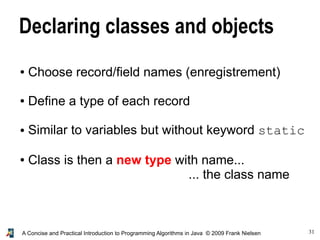
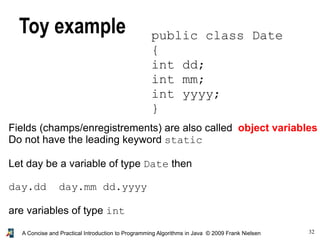
![33A Concise and Practical Introduction to Programming Algorithms in Java © 2009 Frank Nielsen
Toy example
public class Student
{
String Lastname;
String Firstname;
int Company;
double [ ] Marks;
...
}
Class Student encapsulates data attached to a student identity.](https://image.slidesharecdn.com/programmingalgorithmsjava-5-140701005408-phpapp02/85/chapter-5-A-Concise-and-Practical-Introduction-to-Programming-Algorithms-in-Java-33-320.jpg)
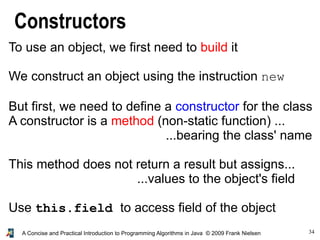
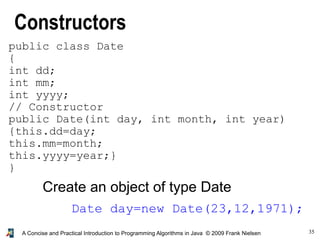
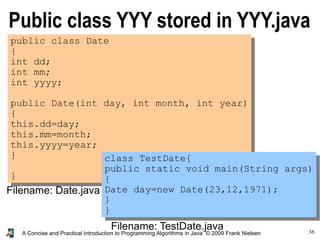
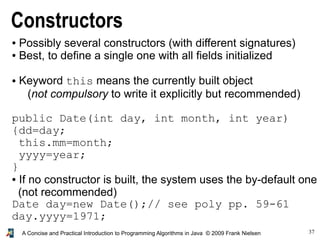
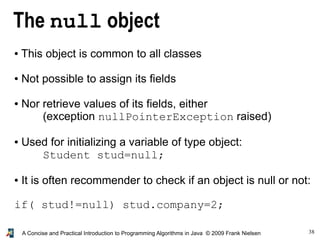
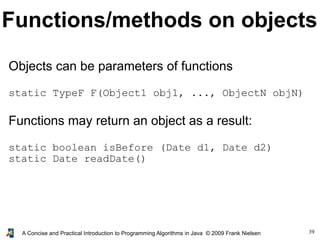
![40A Concise and Practical Introduction to Programming Algorithms in Java © 2009 Frank Nielsen
Examplepublic class Date
{
int dd;
int mm;
int yyyy;
public static final String[ ] months={
"January", "February", "March", "April", "May",
"June", "July", "August", "September", "October",
"November", "December"
};
// Constructor
public Date(int day, int month, int year)
{
this.dd=day;
this.mm=month;
this.yyyy=year;
}
}](https://image.slidesharecdn.com/programmingalgorithmsjava-5-140701005408-phpapp02/85/chapter-5-A-Concise-and-Practical-Introduction-to-Programming-Algorithms-in-Java-40-320.jpg)
![41A Concise and Practical Introduction to Programming Algorithms in Java © 2009 Frank Nielsen
Example
class TestDate{
static void Display(Date d){
System.out.println("The "+d.dd+" "+Date.months[d.mm-
1]+" of "+d.yyyy);
}
static boolean isBefore(Date d1, Date d2)
{
boolean result=true;
if (d1.yyyy>d2.yyyy) result=false;
if (d1.yyyy==d2.yyyy && d1.mm>d2.mm) result=false;
if (d1.yyyy==d2.yyyy && d1.mm==d2.mm && d1.dd>d2.dd)
result=false;
return result;
}
public static void main(String[] args)
{
Date day1=new Date(23,12,1971);
Display(day1);
Date day2=new Date(23,6,1980);
System.out.println(isBefore(day1,day2));
}
}](https://image.slidesharecdn.com/programmingalgorithmsjava-5-140701005408-phpapp02/85/chapter-5-A-Concise-and-Practical-Introduction-to-Programming-Algorithms-in-Java-41-320.jpg)
![42A Concise and Practical Introduction to Programming Algorithms in Java © 2009 Frank Nielsen
class TestDate{
...
static Date lireDate()
{
int jj, mm, aaaa;
System.out.println("Jour?");
jj=TC.lireInt();
System.out.println("Mois?");
mm=TC.lireInt();
System.out.println("Annee?");
aaaa=TC.lireInt();
Date day=new Date(jj,mm,aaaa);
return day;
}
public static void main(String[] args)
{
Display(lireDate());
}
}](https://image.slidesharecdn.com/programmingalgorithmsjava-5-140701005408-phpapp02/85/chapter-5-A-Concise-and-Practical-Introduction-to-Programming-Algorithms-in-Java-42-320.jpg)
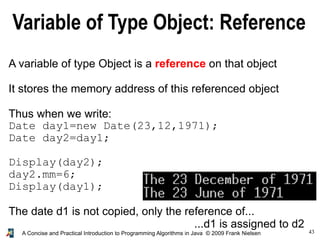

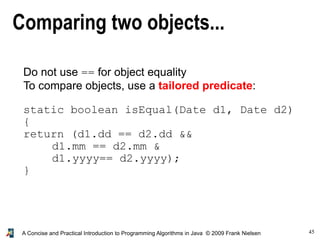
![46A Concise and Practical Introduction to Programming Algorithms in Java © 2009 Frank Nielsen
Comparing two objects...
public static void main(String[] args)
{
Date day1=new Date(23,12,1971);
Date day2=day1; // beware not copying here.
Just memory reference
Date day3=new Date(23,12,1971);
System.out.println(isEqual(day1,day3));
System.out.println(day1);
System.out.println(day2);
System.out.println(day3);
}
Physical (memory) versus logical equality](https://image.slidesharecdn.com/programmingalgorithmsjava-5-140701005408-phpapp02/85/chapter-5-A-Concise-and-Practical-Introduction-to-Programming-Algorithms-in-Java-46-320.jpg)
![47A Concise and Practical Introduction to Programming Algorithms in Java © 2009 Frank Nielsen
Array of objects
● Since classes defines new types...
... we can create array of objects
● To build an array of objects: new nameT[sizearray]
Date [ ] tabDates=new Date[31];
● When an array of object is built, the elements Date[i]
are all initialized to the null object.](https://image.slidesharecdn.com/programmingalgorithmsjava-5-140701005408-phpapp02/85/chapter-5-A-Concise-and-Practical-Introduction-to-Programming-Algorithms-in-Java-47-320.jpg)
![48A Concise and Practical Introduction to Programming Algorithms in Java © 2009 Frank Nielsen
Example
public class Date
{
...
void Display()
{
System.out.println(dd+" "+months[mm-1]+" "+yyyy);
}
...
}
public class XEvent
{
Date when;
String what;
public XEvent(Date d, String text)
{
this.when=d;
this.what=text;
}
} Filename XEvent.java
Filename Date.java](https://image.slidesharecdn.com/programmingalgorithmsjava-5-140701005408-phpapp02/85/chapter-5-A-Concise-and-Practical-Introduction-to-Programming-Algorithms-in-Java-48-320.jpg)
![49A Concise and Practical Introduction to Programming Algorithms in Java © 2009 Frank Nielsen
public class TestXEvent
{
public static void Display(XEvent e)
{
System.out.print(e.what+": ");
e.when.Display();
}
public static void main(String [] args)
{
Date d1=new Date(26,6,2008);
XEvent e1=new XEvent(d1,"Birthday Julien");
Display(e1);
XEvent [] tabEvent=new XEvent[5];
tabEvent[0]=e1;
}
}](https://image.slidesharecdn.com/programmingalgorithmsjava-5-140701005408-phpapp02/85/chapter-5-A-Concise-and-Practical-Introduction-to-Programming-Algorithms-in-Java-49-320.jpg)
![50A Concise and Practical Introduction to Programming Algorithms in Java © 2009 Frank Nielsen
public class TestXEvent
{public static void Display(XEvent e)
{ System.out.print(e.what+": ");
e.when.Display(); }
public static boolean older(XEvent e1, XEvent e2)
{return Date.isBefore(e1.when,e2.when);}
public static XEvent oldest(XEvent[] tab)
{
XEvent result=tab[0];
for(int i=1;i<tab.length;++i)
if (older(tab[i],result)) result=tab[i];
return result;
}
public static void main(String [] args)
{
Date d1=new Date(26,6,2003);
XEvent e1=new XEvent(d1,"Birthday Julien");
Date d2=new Date(20,11,2000);
XEvent e2=new XEvent(d2,"Birthday Audrey");
Date d3=new Date(23,6,1971);
XEvent e3=new XEvent(d3,"Birthday Me");
Display(e1);
XEvent [] tabEvent=new XEvent[3];
tabEvent[0]=e1;tabEvent[1]=e2;tabEvent[2]=e3;
System.out.print("Oldest person::");Display(oldest(tabEvent));
}
}](https://image.slidesharecdn.com/programmingalgorithmsjava-5-140701005408-phpapp02/85/chapter-5-A-Concise-and-Practical-Introduction-to-Programming-Algorithms-in-Java-50-320.jpg)
![51A Concise and Practical Introduction to Programming Algorithms in Java © 2009 Frank Nielsen
Objects with array members
Fields of objects may be arrays themselves
always built with new Type[sizearray]
// sizearray might be an expression, i.e., 3*n+2
It is not necessary at compile time to know statically...
.... the array sizes
class Polynome{
int degree;
double [ ] coefficients;
};](https://image.slidesharecdn.com/programmingalgorithmsjava-5-140701005408-phpapp02/85/chapter-5-A-Concise-and-Practical-Introduction-to-Programming-Algorithms-in-Java-51-320.jpg)
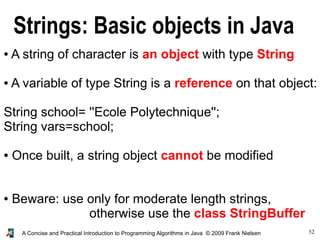
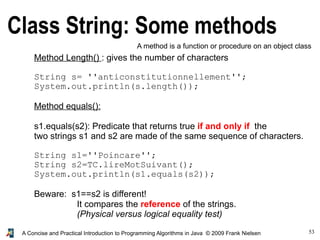
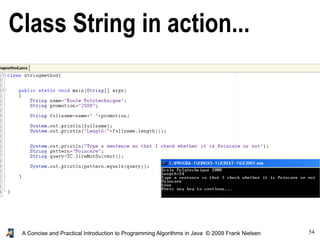
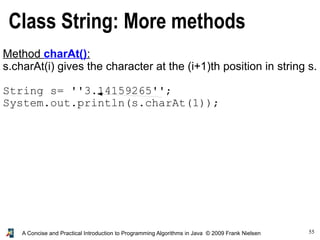

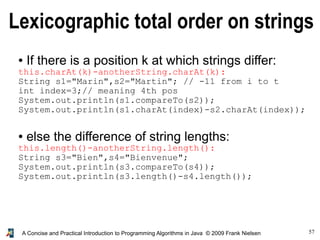
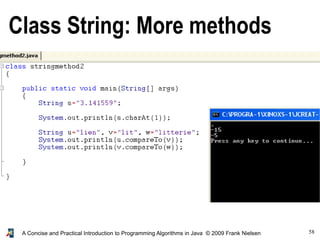
![59A Concise and Practical Introduction to Programming Algorithms in Java © 2009 Frank Nielsen
Demystifying the main function
class ClassName
{
public static void main(String[ ] args)
{
...
}
}
Function main has an array of string of characters as arguments
These strings are stored in args[0], args[1], ...
... when calling java main s0 s1 s2 s3
Use Integer.parseInt() to convert a string into an integer](https://image.slidesharecdn.com/programmingalgorithmsjava-5-140701005408-phpapp02/85/chapter-5-A-Concise-and-Practical-Introduction-to-Programming-Algorithms-in-Java-59-320.jpg)
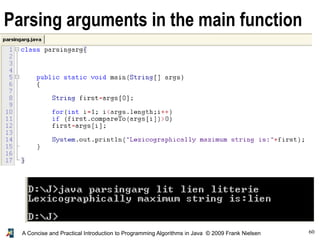
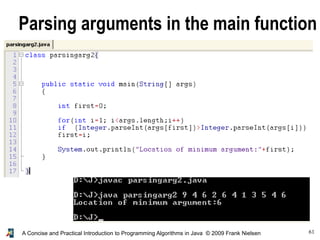
![62A Concise and Practical Introduction to Programming Algorithms in Java © 2009 Frank Nielsen
More evolved Java
program skeleton...
2 versus (!=) 3
(2,1)
(3,4)
class Point
{
int x,y;
Point(int xx, int yy){x=xx;y=yy;}
public void Display()
{System.out.println("("+x+","+y+")")}
} // end of class Point
class Skeleton
{
// Static class variables
static int nbpoint=0;
static double x;
static boolean [] prime;
static int f1(int p){return p/2;}
static int f2(int p){return 2*p;}
public static void main(String [] argArray)
{
System.out.println(f2(f1(3))+" versus (!=) "+f1(f2(3)));
Point p,q;
p=new Point(2,1); nbpoint++;
q=new Point(3,4); nbpoint++;
p.Display();q.Display();
} }](https://image.slidesharecdn.com/programmingalgorithmsjava-5-140701005408-phpapp02/85/chapter-5-A-Concise-and-Practical-Introduction-to-Programming-Algorithms-in-Java-62-320.jpg)
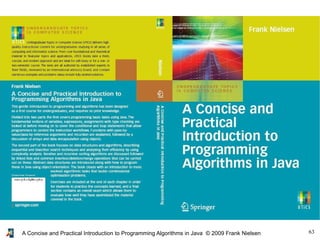










![[C++] The Curiously Recurring Template Pattern: Static Polymorphsim and Expre...](https://cdn.slidesharecdn.com/ss_thumbnails/crtptechtalk-170213220301-thumbnail.jpg?width=560&fit=bounds)












































































